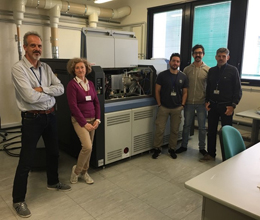TIMS and MC-ICP-MS Isotope Labs

Since its birth, isotope geochemistry had a huge influence on scientific thought. Earth Sciences are the disciplines that had drawn most benefits. In particular, solid-source Mass Spectrometry or Thermal Ionization Mass Spectrometry (TIMS), since the pioneering studies of A. Nier who in 1930s systematically investigated the isotopic composition of solid elements, was used to investigate parent-daughter radioactive systematics, which allowed to determine rock ages, describe the heterogeneities in the Earth’s crust and mantle, and set up paleoclimatic reconstructions.
Currently, the TIMS technique is used for a wide spectrum of applications in Earth and Environmental Sciences (geochronology, isotope geochemistry, pollution tracking). Other common application are in Food Sciences, Nuclear Sciences, Archaeological Sciences (Archaeometry) and Forensic Geology.
In the TIMS technique, the element to be analyzed needs to be separated from the matrix, usually in a clean room laboratory, then loaded on a very thin Re or Ta ribbon and ionized in a ultra vacuum source by Joule’s effect. Produced ions, moved and focused by electromagnetic fields, enter into a magnetic separator, where they are differentially bent according to their mass/charge ratios. Then, the ion beams are collected and analyzed into one or more detectors.
In the last three decades, the most important technical advancement was the coupling of a ICP (Inductively Coupled Plasma) source with a High Resolution Multi Collector Mass Spectrometer, giving rise to the HR-MC-ICP-MS. Rather than being alternative to the TIMS, (Thermal Ionization Mass Spectrometers), the MC-ICP-MS, given the high ionization capability of plasma source, allowed to study a lot of isotope systematics, including both radiogenic or stable isotopes.
During September, 2017, a latest generation High Resolution MC-ICP-MS was installed by IGG in Pisa.
